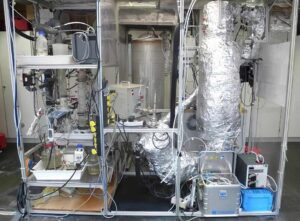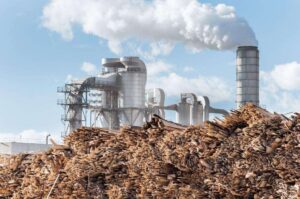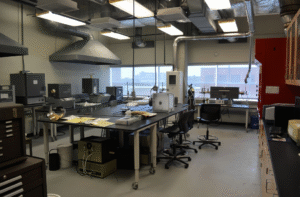The emission limits for air pollutants in the cement industry, such as NOx, SO2, and NH3, are all in mg/Nm3 and have a baseline O2 content of 10%. Many instruments measure air pollutants in ppm, and generally, instruments can set this unit to mg/Nm3.
If you get a figure in ppm, how do you convert it to mg/Nm3?
(1) Conversion of ppm and mg/Nm3
ppm is short for parts per million, and million means million, so ppm means parts per million. ppm doesn’t have a unit, it’s parts per million and can be either a volumetric concentration or a mass concentration. For atmospheric pollutants, it is generally the volume concentration. mg/Nm3 means how much gas is in 1 Nm3 (how many mg). You need to know how many moles (mol) of gas there are in 1 Nm3; the weight of 1 mol of gas is its relative molecular mass (molar mass,g/mol); and then by using the number of moles × the relative molecular mass, you can know its mass (g). Where 1 mol of any gas has a volume of 22.4 L at standard conditions [note that this is at standard conditions]. 1 Nm3 of gas volume = 1000 L, which is equivalent to 1000/22.4 = 44.64 mol. This is true for all gases, i.e., 1 Nm3 of NO is 44.64 mol, and so is 1 Nm3 of SO2. the relative molecular mass of a gas is the relative atomic mass of the individual atoms. The relative molecular mass of a gas is the sum of the relative atomic masses of the individual atoms. For example, the relative molecular mass of NO is, the relative atomic mass of N is 14 + the relative atomic mass of O is 16 = 30. It means that the weight of 1 mol of NO is 30 g. In this way, we can find out the weight of 1 Nm3 of NO: 1000/22.4×30 = 1339 g/Nm3. Then the 1 ppm of NO, which means that 1 Nm3 of flue gas has only one part per million, that is, 1/100th of a part per million of the weight of the gas, is 1/100th of a part per million. Then 1 ppm of NO, meaning 1 Nm3 of flue gas contains only one part in a million, that is, 1/1,000,000 Nm3. 1/1,000,000 Nm3 of NO weight: 1/1,000,000×1000/22.4×30×1000 = 1.339 mg/Nm3. 1,000 in the formula means 1 Nm3=1,000 L; the second 1,000 means 1 g=1,000 mg. multiplying the two 1,000s is 1,000,000. One million. That is, in addition to 1 million, multiplied by 1 million, equals 1.
So simply put, 1 ppm NO = relative molecular mass of NO/22.4 = 30/22.4 = 1.339 mg/Nm3. Similarly, 1 ppm NO2 = relative molecular mass of NO2/22.4 = 46/22.4 = 2.05 mg/Nm3; 1 ppm SO2 = relative molecular mass of SO2/22.4 = 64/22.4 = 2.857 mg/Nm3. 2.857 mg/Nm3.
1 ppm NH3 = relative molecular mass of NH3/22.4 = 17/22.4 = 0.759 mg/Nm3. If the measured NO content of the flue gas is 100 ppm, then the conversion to mg/Nm3 is 133.9 mg/Nm3.
(2 )Specificity of NOx
For SO2, NH3, according to the above calculations is no problem, but NOx can not. The reason is that in the air pollutant emission standards NOx is counted as NO2, meaning that the NO, NO2 in the flue gas should be regarded as NO2.
For example, 1 ppm NO is 1.339 mg/Nm3, which is in terms of NO; if it is in terms of NO2, it is the relative molecular mass of NO2/22.4 = 46/22.4 = 2.05, which is the same as 1 ppm NO2 is 2.05 mg/Nm3. So, if the flue gas has 50 ppm NO and 10 ppm NO2, what is the conversion to NOx? = (50+10) × 46/22.4 = 123.2 mg/Nm3 (in NO2)
That is, just add the number of ppm of NO and NO2 and x 2.05.
(3) Baseline for O2
The benchmark O2 in the cement industry air pollutant emission limits is 10% (some industries are 6%, some are 16%, etc.).
Benchmark O2 content of 10% means that, if the flue gas O2 content <10%, then converted to the benchmark O2 is equivalent to the dilution of the next; Conversely, if the flue gas O2 content > 10%, then converted to the benchmark O2 is equivalent to the concentration of the next. In this way, we are on the same starting line, to prevent some enterprises from reducing the concentration of pollutants, deliberately leaking into the air. From this level, if the source concentration of NOx is certain, no matter how much air leakage behind you, the final NOx value emitted from the stack is unchanged (after discounting oxygen). This also answers the question of many companies, “After the SCR system, no matter how much air leakage you have converted to the baseline O2 content under the NOx concentration is unchanged”.
The premise of this statement is founded on two, 1) O2 content can not be too high flue gas analyzer to detect the data accurately, and some flue gas analyzers may exist O2 content is very high when the detection of the deviation increases, especially O2 content close to the O2 content of the air; 2) leakage of the role played by the air is just a dilution, will not affect the generation and reduction of NOx, if it is the decomposition furnace or preheater leakage, may affect the amount of NOx source.
For example, if the flue gas has 50 ppm NO, 10 ppm NO2, and the flue gas O2 content is 6%, then what is the NOx emission concentration converted to the baseline O2 content?
= (50+10)×46/22.4×(21%-10%)/(21%-6%) = 90.4 mg/Nm3@10%O2.









